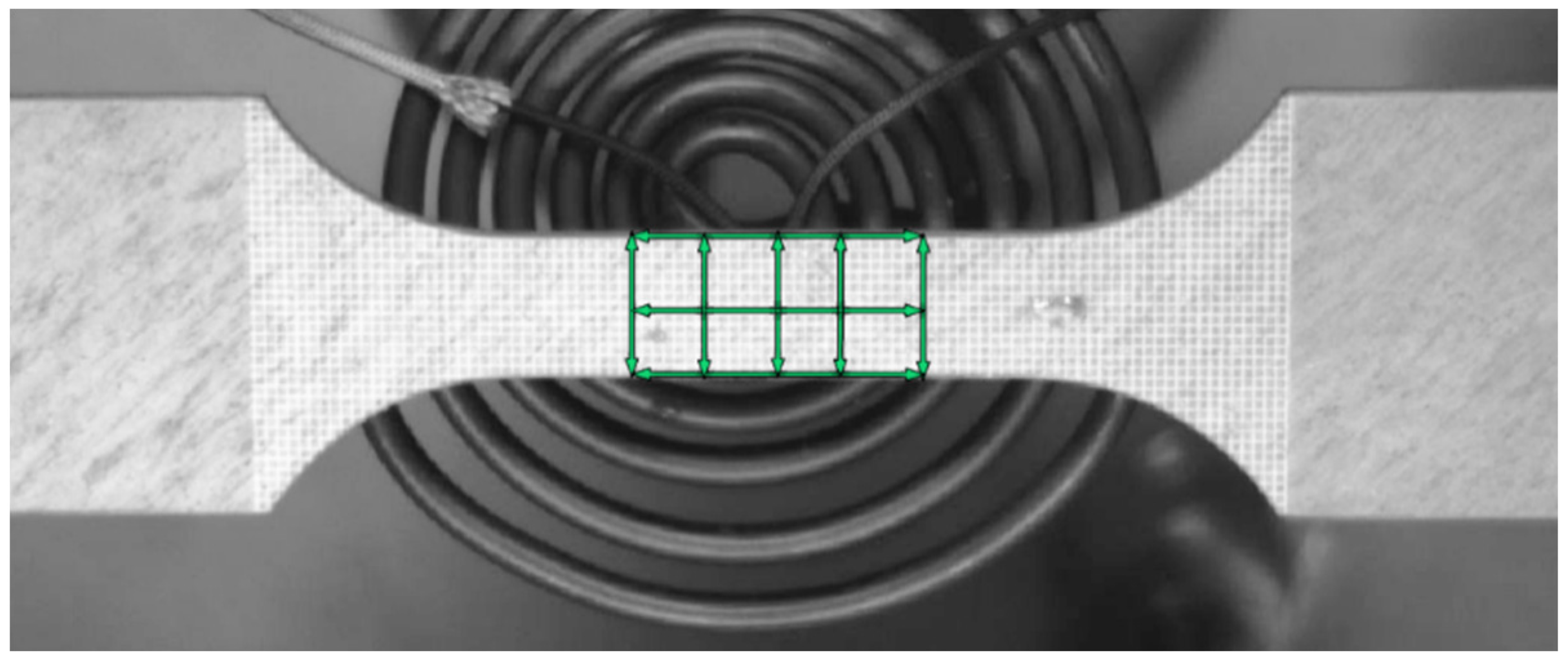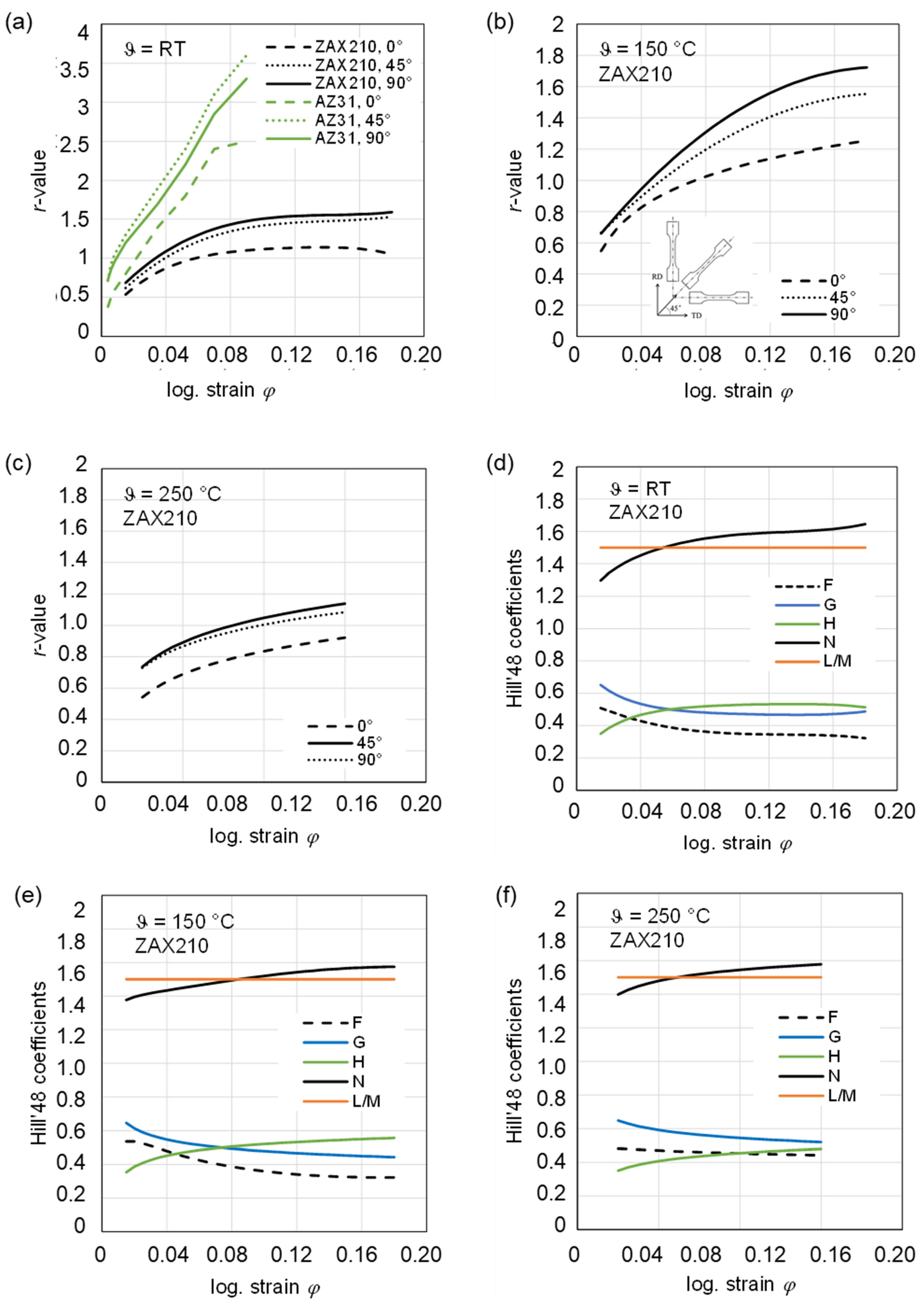Orthotropic Behavior of Twin-Roll-Cast and Hot-Rolled Magnesium ZAX210 Sheet
Abstract
1. Introduction
2. Materials and Methods
2.1. Materials
2.2. Experimental Setup
2.3. Graphical Evaluation
2.4. Hill’48 Yield Criterion
- (1)
- When the sheet metal is deep drawn, the biaxial compressive stress in the sheet metal plane will not cause the so-called “thickening” of the sheet metal. If there is surface compressive stress, only wrinkles are formed, which macroscopically combine to form a larger sheet cross-section due to the high pressure in the press.
- (2)
- In the special case of the inner bending radius, the small appearance of compressive stress can be neglected in the modeling.
- (3)
- The manufacturing tolerance of a cylindrical compression specimen in the plane of the plate (direction of compression equal to direction of sheet thickness) is too large compared to the plate with a thickness of 1.5 mm, and the calculation of the flow curve will be accompanied by a large error.
3. Results and Discussion
3.1. Microstructure and Texture of the Initial State
3.2. Variation in r-Values with Logarithmic Strain and Temperature and Hill’48 Coefficients
3.3. Yield Loci Calculated Using Mises and Hill’48
4. Conclusions
- (1)
- The r-values are small (0.5 to 0.7) during the early stage of deformation and increase with local logarithmic strain. At all tested temperatures, there is a tendency that r90° > r45° > r0°.
- (2)
- The obtained r-values are a direct result of the crystallographic texture present in the ZAX210 alloy, combined with the relative resolved shear strengths of the slip and twinning systems.
- (3)
- The plane anisotropy Δr is between 0 and–0.2 at all tested temperatures. These values indicate a slight anisotropic behavior in the sheet plane.
- (4)
- The calculated yield loci using von Mises and Hill’48 yield functions depending on logarithmic strain and temperature for the ZAX210 sheets reveal an isotropic behavior, where Hill’48 and Mises converge and an approximately planar isotropic material behavior at low temperature 150 °C can be assumed even for moderately higher strains compared to AZ31.
- (5)
- The in-plane material flow behavior can be identified as orthotropic with decreasing anisotropy at elevated temperatures.
Author Contributions
Funding

Institutional Review Board Statement
Informed Consent Statement
Data Availability Statement
Conflicts of Interest
References
- Hama, T.; Takuda, H. Crystal plasticity finite-element simulation of work-hardening behavior in a magnesium alloy sheet under biaxial tension. Comput. Mater. Sci. 2012, 51, 156–164. [Google Scholar] [CrossRef]
- Shi, B.; Yang, C.; Peng, Y.; Zhang, F.; Pan, F. Anisotropy of wrought magnesium alloys: A focused overview. J. Magnes. Alloy. 2022, 10, 1476–1510. [Google Scholar] [CrossRef]
- Davis, A.E.; Robson, J.D.; Turski, M. Reducing yield asymmetry and anisotropy in wrought magnesium alloys—A comparative study. Mater. Sci. Eng. A 2019, 744, 525–537. [Google Scholar] [CrossRef]
- Drozdenko, D.; Bohlen, J.; Yi, S.B.; Minárik, P.; Chmelík, F.; Dobroň, P. Investigating a twinning–detwinning process in wrought Mg alloys by the acoustic emission technique. Acta Mater. 2016, 110, 103–113. [Google Scholar] [CrossRef]
- Kamrani, S.; Fleck, C. Effects of calcium and rare-earth elements on the microstructure and tension–compression yield asymmetry of ZEK100 alloy. Mater. Sci. Eng. A 2014, 618, 238–243. [Google Scholar] [CrossRef]
- Wang, J.; Li, X.; Jin, P.; Li, S.; Ma, G.; Zhao, L. Reducing the tension-compression yield asymmetry in an extruded ZK60 alloy by ultrafine grains. Mater. Res. Express 2018, 5, 116518. [Google Scholar] [CrossRef]
- Dobroň, P.; Drozdenko, D.; Olejňák, J.; Hegedüs, M.; Horváth, K.; Veselý, J.; Bohlen, J.; Letzig, D. Compressive yield stress improvement using thermomechanical treatment of extruded Mg-Zn-Ca alloy. Mater. Sci. Eng. A 2018, 730, 401–409. [Google Scholar] [CrossRef]
- Barnett, M.R.; Nave, M.D.; Ghaderi, A. Yield point elongation due to twinning in a magnesium alloy. Acta Mater. 2012, 60, 1433–1443. [Google Scholar] [CrossRef]
- Langelier, B.; Nasiri, A.M.; Lee, S.Y.; Gharghouri, M.A.; Esmaeili, S. Improving microstructure and ductility in the Mg–Zn alloy system by combinational Ce–Ca microalloying. Mater. Sci. Eng. A 2015, 620, 76–84. [Google Scholar] [CrossRef]
- Stanford, N. The effect of calcium on the texture, microstructure and mechanical properties of extruded Mg–Mn–Ca alloys. Mater. Sci. Eng. A 2010, 528, 314–322. [Google Scholar] [CrossRef]
- Nakata, T.; Xu, C.; Ajima, R.; Matsumoto, Y.; Shimizu, K.; Sasaki, T.T.; Hono, K.; Kamado, S. Improving mechanical properties and yield asymmetry in high-speed extrudable Mg-1.1Al-0.24Ca (wt%) alloy by high Mn addition. Mater. Sci. Eng. A 2018, 712, 12–19. [Google Scholar] [CrossRef]
- Song, B.; Wang, C.; Guo, N.; Pan, H.; Xin, R. Improving Tensile and Compressive Properties of an Extruded AZ91 Rod by the Combined Use of Torsion Deformation and Aging Treatment. Materials 2017, 10, 280. [Google Scholar] [CrossRef] [PubMed]
- Agnew, S.R.; Brown, D.W.; Tome, C.N. Validating a polycrystal model for the elastoplastic response of magnesium alloy AZ31 using in situ neutron diffraction. Acta Mater. 2006, 54, 4841–4852. [Google Scholar] [CrossRef]
- Homma, T.; Mendis, C.L.; Hono, K.; Kamado, S. Effect of Zr addition on the mechanical properties of as-extruded Mg–Zn–Ca–Zr alloys. Mater. Sci. Eng. A 2010, 527, 2356–2362. [Google Scholar] [CrossRef]
- Robson, J.D.; Twier, A.M.; Lorimer, G.W.; Rogers, P. Effect of extrusion conditions on microstructure, texture, and yield asymmetry in Mg–6Y–7Gd–0.5wt%Zr alloy. Mater. Sci. Eng. A 2011, 528, 7247–7256. [Google Scholar] [CrossRef]
- Robson, J.D.; Stanford, N.; Barnett, M.R. Effect of precipitate shape on slip and twinning in magnesium alloys. Acta Mater. 2011, 59, 1945–1956. [Google Scholar] [CrossRef]
- Sasaki, T.T.; Elsayed, F.R.; Nakata, T.; Ohkubo, T.; Kamado, S.; Hono, K. Strong and ductile heat-treatable Mg–Sn–Zn–Al wrought alloys. Acta Mater. 2015, 99, 176–186. [Google Scholar] [CrossRef]
- Ullmann, M.; Kittner, K.; Henseler, T.; Stöcker, A.; Prahl, U.; Kawalla, R. Development of new alloy systems and innovative processing technologies for the production of magnesium flat products with excellent property profile. Procedia Manuf. 2019, 27, 203–208. [Google Scholar] [CrossRef]
- Kittner, K.; Ullmann, M.; Henseler, T.; Kawalla, R.; Prahl, U. Microstructure and Hot Deformation Behavior of Twin Roll Cast Mg-2Zn-1Al-0.3Ca Alloy. Materials 2019, 12, 1020. [Google Scholar] [CrossRef]
- Hill, R. A theory of the yielding and plastic flow of anisotropic metals. Proc. R. Soc. Lond. A 1948, 193, 281–297. [Google Scholar] [CrossRef]
- Agnew, S.R. Plastic anisotropy of magnesium alloy AZ31B sheet. In Essential Readings in Magnesium Technology; Springer: Cham, Switzerland, 2002; pp. 169–174. [Google Scholar]
- Yi, S.; Bohlen, J.; Heinemann, F.; Letzig, D. Mechanical anisotropy and deep drawing behaviour of AZ31 and ZE10 magnesium alloy sheets. Acta Mater. 2010, 58, 592–605. [Google Scholar] [CrossRef]
- Duygulu, Ö.; Agnew, S.R. The effect of temperature and strain rate on the tensile properties of textured magnesium alloy AZ31B sheet. Magnes. Technol. 2003, 237, 242. [Google Scholar]
- Andar, M.O.; Kuwabara, T.; Steglich, D. Material modeling of AZ31 Mg sheet considering variation of r-values and asymmetry of the yield locus. Mater. Sci. Eng. A 2012, 549, 82–92. [Google Scholar] [CrossRef]






| Zn | Al | Ca | Mn | Cu | Fe | Ni | Others | Mg |
|---|---|---|---|---|---|---|---|---|
| 2.290 | 0.920 | <0.250 | 0.040 | 0.001 | 0.005 | 0.001 | <0.045 | Bal. |
| Log. Strain | F | G | H | L | M | N |
|---|---|---|---|---|---|---|
| 0.015 | 0.5079 | 0.6511 | 0.3489 | 1.5 | 1.5 | 1.2977 |
| 0.05 | 0.4043 | 0.5123 | 0.877 | 1.5 | 1.5 | 1.4878 |
| 0.1 | 0.3499 | 0.4724 | 0.5276 | 1.5 | 1.5 | 1.5791 |
| 0.18 | 0.3222 | 0.4872 | 0.5128 | 1.5 | 1.5 | 1.6454 |
Publisher’s Note: MDPI stays neutral with regard to jurisdictional claims in published maps and institutional affiliations. |
© 2022 by the authors. Licensee MDPI, Basel, Switzerland. This article is an open access article distributed under the terms and conditions of the Creative Commons Attribution (CC BY) license (https://creativecommons.org/licenses/by/4.0/).
Share and Cite
Ullmann, M.; Kaden, C.; Kittner, K.; Prahl, U. Orthotropic Behavior of Twin-Roll-Cast and Hot-Rolled Magnesium ZAX210 Sheet. Materials 2022, 15, 6437. https://doi.org/10.3390/ma15186437
Ullmann M, Kaden C, Kittner K, Prahl U. Orthotropic Behavior of Twin-Roll-Cast and Hot-Rolled Magnesium ZAX210 Sheet. Materials. 2022; 15(18):6437. https://doi.org/10.3390/ma15186437
Chicago/Turabian StyleUllmann, Madlen, Christoph Kaden, Kristina Kittner, and Ulrich Prahl. 2022. "Orthotropic Behavior of Twin-Roll-Cast and Hot-Rolled Magnesium ZAX210 Sheet" Materials 15, no. 18: 6437. https://doi.org/10.3390/ma15186437
APA StyleUllmann, M., Kaden, C., Kittner, K., & Prahl, U. (2022). Orthotropic Behavior of Twin-Roll-Cast and Hot-Rolled Magnesium ZAX210 Sheet. Materials, 15(18), 6437. https://doi.org/10.3390/ma15186437









